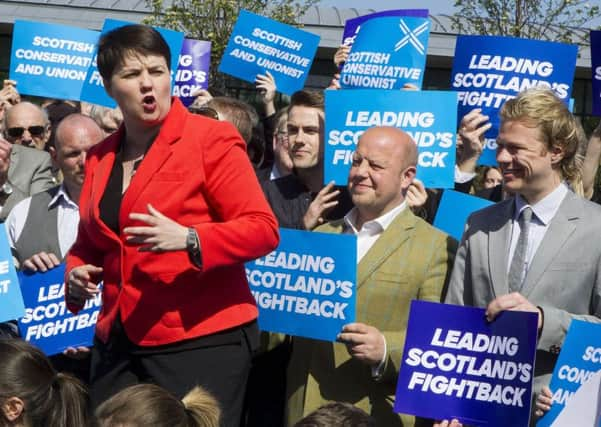Analysis: Are Scottish Tories election predictions too high?


The Scottish Conservative revival has commentators the length and breadth of the UK talking up everything from the chance of a Nicola Sturgeon slump to a Ruth Davidson premiership.
Ruth Davidson’s party put in another good electoral performance at last week’s local elections to match their strong show in the Holyrood elections of 2016.
Advertisement
Hide AdAdvertisement
Hide AdWith a general election looming in which the party at UK level is expected to dominate, many are talking about the prospects of a Tory breakthrough in Scotland come June 8.
Some SNP MPs have majorities that can be overturned, while others are fearing an anti-independence or even pro-Brexit backlash.
May 2015 saw Nicola Sturgeon’s party win 56 of 59 seats and exactly 50 per cent of the vote – even their most positive predictions allow for a slight fall in both.
The Conservatives believe that they can take as many as 15 seats at the general election, and firmly solidify themselves as the second force in Scottish politics.
But is this going too far? Have they bought their own hype? We analyse whether pride could lead to a fall for Ruth Davidson’s party.
Why make bold predictions?
‘Expectation management’ is important in politics – the notion that you should always temper predictions of success with notes of caution.
This is most noticeable at the UK level, where Theresa May, despite enjoying a massive poll lead over Jeremy Corbyn, is warning voters that her victory isn’t a done deal yet.
According to a briefing from Conservative sources to pro-Tory newspapers, the Ruth Davidson strategy of expectation management has simply ‘gone out the window’.
Advertisement
Hide AdAdvertisement
Hide AdIt is that which is leading her party to predict that they could win over a dozen seats and claim scalps like that of Deputy SNP leader Angus Robertson.
There are a number of reasons to project this air of confidence, even if it is backed up by private and public polling.
Firstly, it can help fire up activists.
Party volunteers are the (often thankless) footsoldiers of any political movement, but they can be motivated more by working for a winning cause.
It also helps with the appearance of ‘momentum’ – that flighty concept that parties often crave to convince that they are the winning campaign.
Finally, it could help stretch the resources of opponents – forcing them to move money and activists to seats previously thought safe.
Potential drawbacks
Ruth Davidson probably doesn’t seek the advice of Alex Salmond, but the former First Minister could offer a cautionary tale on making predictions while still enjoying the first flush of electoral success.
The big beast of Scottish politics announced in 2008, fresh of the SNP’s success in the Glasgow East by-election, that the party would be targeting winning 20 seats in the 2010 general election.
As it happened, the Lib Dem surge and the fear of ‘letting in the Tories’ left the party with just the six seats that they already held, and was reckoned a big setback for the SNP.
Advertisement
Hide AdAdvertisement
Hide AdIf the Tories fail to reach their own self-proclaimed target at the election next month, opponents will paint it as a very bad night for Ruth Davidson’s party.
This is especially true if they also fail to claim a notable scalp like the aforementioned Mr Robertson or Mr Salmond, two seats where the party have been publicly bullish about their chances.
A mixed night?
All of that, perhaps deliberately, somewhat blurs the line of what a good night for Ruth Davidson’s party looks like.
Unless the Conservatives have information others don’t, it remains incredibly difficult to see them reaching the heights of 14 or 15 seats.
Indeed, achieving half that number of MPs would still, in ordinary circumstances, be a pretty stunning achievement for Ruth Davidson, especially if she helps increase the share of the vote from the 16.7 per cent they got in 2015.
A handful of SNP seats are almost certain to fall to the Conservatives, with Callum Kerr defending just a three figure majority in Berwickshire, Roxburgh and Selkirk.
The Tories are odds-on favourites in Dumfries and Galloway, West Aberdeenshire and Kincardine, East Renfrewshire (formerly Jim Murphy’s seat), and five other seats.
The bookies, therefore, are predicting 10 Tory wins, including the seat they already hold in Dumfriesshire.
Advertisement
Hide AdAdvertisement
Hide AdOddsmakers, however, often don’t take into account incumbency and other local factors, as well as the strength of the local candidates.
Angus Robertson in Moray, for example, is an MP of 16 years standing with a burgeoning profile in UK-wide politics – no matter the national swing to Ruth Davidson’s party, he will be very hard to dislodge.
Predicting political results is always difficult, even for political parties.
Ruth Davidson is recognised as one of the more successful politicians of recent times, but her revitalised party looks set to be poorly served by some of her bolder predictions.
15 seats in Scotland still seems like a pipe dream for the Conservatives, and politicians should be wary about confusing pipe dreams and serious predictions.
That’s a lesson that the Tories could learn harshly next month.
